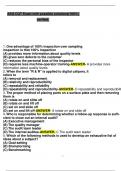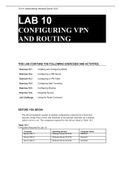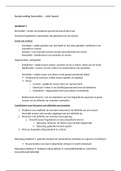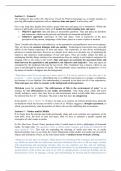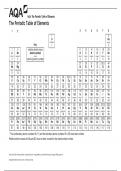The central nervous system; Class notes
The central nervous system comprises of the brain and spinal cord. It is mentioned to as
“central” for the reason that it chains information from the whole body and directs activity
across the entire organism.
1. Fast facts on the central nervous system
. The CNS is made up of the brain and spinal cord.
The brain is the greatest complex organ in the body and uses 20% of the total oxygen
we inhale.
The brain consist of possible 100 billion neurons, with each connected to thousands
more.
The brain can be differentiated into four main lobes: temporal, parietal, occipital and
frontal.
2. What is the central nervous system?
It is the share of the nervous system which in vertebrates includes the brain and spinal cord,
to which sensory impulses are conveyed and from which motor impulses pass out, and which
guides the activity of the entire nervous system
The CNS consists of the brain and spinal cord:
The brain is covered an protected by the skull (cranial cavity) and the spinal cord moves
from the back of the brain, down the middle of the spine, ending in the lumbar region of the
lower back.
The brain and spinal cord are equally contained within a protective triple-layered membrane
called the meninges.
The central nervous system regulates our thoughts, movements, feelings, and needs. It also
regulates our breathing, heart rate, the release of some hormones, body temperature, and
much more.
The retina, optic nerve, olfactory nerves, and olfactory epithelium are occasionally measured
to be part of the CNS in conjunction with the brain and spinal cord. This is for the reason that
they link directly with brain tissue without intermediate nerve fibers.
, 3. The brain
The brain has various complex roles mentioned above and to carry out these functions, some
segments of the brain have devoted roles. Though, several complex functions — reasoning,
problem-solving, creativity — include diverse parts working together in system.
The brain is roughly divided into four lobes:
Temporal lobe (green): vital for processing sensory input and assigning it emotional
meaning.
It is also contained in setting down long-term memories. Some parts of language perception
are also accommodated here.
Occipital lobe (purple): visual processing region of the brain, covering the visual cortex.
Parietal lobe (yellow): the parietal lobe assimilates sensory information including touch,
spatial awareness, and navigation.
Touch stimulation from the skin is ultimately sent to the parietal lobe. It also plays a part in
language processing.
Frontal lobe (pink): located at the front of the brain, the frontal lobe comprises the
mainstream of dopamine-sensitive neurons and is included in attention, reward, short-term
memory, motivation, and planning.
4. Brain regions
Basal ganglia: plays a role in the regulation of voluntary motor movements, practical
learning, and choices about which motor activities to convey. Illnesses that affect this
part are Parkinson’s disease and Huntington’s disease.
Cerebellum: frequently functions in specific motor control, additionally in language
and attention. Suppose the cerebellum is impaired, the main sign is disrupted motor
control, referred to as ataxia.
Broca’s area: this minor part on the left side of the brain (occasionally on the right on
persons the left hand) is significant in language processing. When damaged, a person
will finds it challenging to speak but can still comprehend speech. Stammering is with
an underactive Broca’s area.
The central nervous system comprises of the brain and spinal cord. It is mentioned to as
“central” for the reason that it chains information from the whole body and directs activity
across the entire organism.
1. Fast facts on the central nervous system
. The CNS is made up of the brain and spinal cord.
The brain is the greatest complex organ in the body and uses 20% of the total oxygen
we inhale.
The brain consist of possible 100 billion neurons, with each connected to thousands
more.
The brain can be differentiated into four main lobes: temporal, parietal, occipital and
frontal.
2. What is the central nervous system?
It is the share of the nervous system which in vertebrates includes the brain and spinal cord,
to which sensory impulses are conveyed and from which motor impulses pass out, and which
guides the activity of the entire nervous system
The CNS consists of the brain and spinal cord:
The brain is covered an protected by the skull (cranial cavity) and the spinal cord moves
from the back of the brain, down the middle of the spine, ending in the lumbar region of the
lower back.
The brain and spinal cord are equally contained within a protective triple-layered membrane
called the meninges.
The central nervous system regulates our thoughts, movements, feelings, and needs. It also
regulates our breathing, heart rate, the release of some hormones, body temperature, and
much more.
The retina, optic nerve, olfactory nerves, and olfactory epithelium are occasionally measured
to be part of the CNS in conjunction with the brain and spinal cord. This is for the reason that
they link directly with brain tissue without intermediate nerve fibers.
, 3. The brain
The brain has various complex roles mentioned above and to carry out these functions, some
segments of the brain have devoted roles. Though, several complex functions — reasoning,
problem-solving, creativity — include diverse parts working together in system.
The brain is roughly divided into four lobes:
Temporal lobe (green): vital for processing sensory input and assigning it emotional
meaning.
It is also contained in setting down long-term memories. Some parts of language perception
are also accommodated here.
Occipital lobe (purple): visual processing region of the brain, covering the visual cortex.
Parietal lobe (yellow): the parietal lobe assimilates sensory information including touch,
spatial awareness, and navigation.
Touch stimulation from the skin is ultimately sent to the parietal lobe. It also plays a part in
language processing.
Frontal lobe (pink): located at the front of the brain, the frontal lobe comprises the
mainstream of dopamine-sensitive neurons and is included in attention, reward, short-term
memory, motivation, and planning.
4. Brain regions
Basal ganglia: plays a role in the regulation of voluntary motor movements, practical
learning, and choices about which motor activities to convey. Illnesses that affect this
part are Parkinson’s disease and Huntington’s disease.
Cerebellum: frequently functions in specific motor control, additionally in language
and attention. Suppose the cerebellum is impaired, the main sign is disrupted motor
control, referred to as ataxia.
Broca’s area: this minor part on the left side of the brain (occasionally on the right on
persons the left hand) is significant in language processing. When damaged, a person
will finds it challenging to speak but can still comprehend speech. Stammering is with
an underactive Broca’s area.



